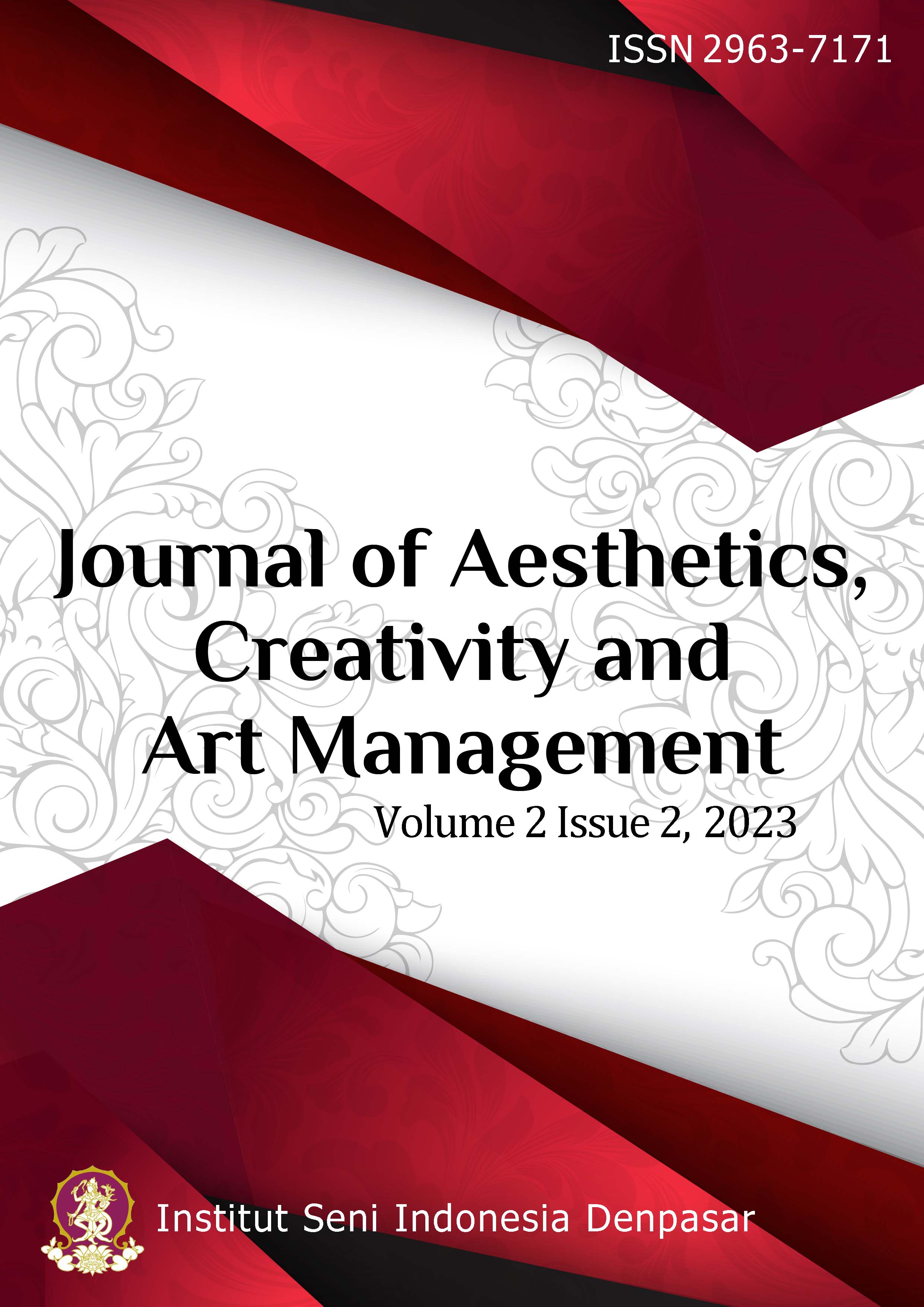The Kalpika Natha Mascot Dance: A Substance of Anthropological, Semiotic, and Aesthetic Studies
DOI:
https://doi.org/10.59997/jacam.v2i2.2804Keywords:
Mascot Dance; Kalpika Natha; symbol; Anthropology; Semiotics; AestheticsAbstract
The creation of a mascot dance entitled Kalpika Natha at SMP Negeri 2 Abiansemal is one of the ideas to create a symbol or identity through performing arts including dance, vocal art, and karawitan. In this interdisciplinary research, anthropological, semiotic, and aesthetic approaches are used. In anthropological studies, the art of mascot dance can be studied from the point of view of cultural and social aspects. The Kalpika Natha Mascot Dance as a representation of organizational identity can be a reflection of societal values and norms. Apart from that, the Kalpika Natha Mascot Dance can also be a medium to introduce and promote the culture of a region or country. Semiotic studies can assist in understanding the meaning and symbols contained therein which are interpreted through semiotic analysis to reveal the message the choreographer wants to convey. Furthermore, in the study of aesthetics, it can be seen from the form, the weight of the content of the Kalpika Natha dance. In this research, interdisciplinary studies of anthropology, semiotics, and aesthetics can provide a more comprehensive understanding of mascot dance as a form of performing art and promotional media. Thus, this research can provide broader implications for the development of the Kalpika Natha Dance in the future.
References
Dewi, L. I. P., Hartawan, I. Y., & Sukajaya, I. N. (2019). Etnomatematika dalam Tari Bali Ditinjau dari Klasifikasi Tari Bali. Jurnal Pendidikan Dan Pembelajaran Matematika Indonesia, 8(1), 39-48.
Gunarta, I. W. A. (2020). Tari Sekar Pudak, Maskot Desa Darmasaba. Segara Widya: Jurnal Penelitian Seni, 8(2), 139-148.
Karja, I. W. (2023). “Nyepi, Balinese Silence Day in Contemporary Painting Practice.” Social Media, Cyber Religion and Culture, Aster Publishing. New Delhi. p. 344-457.
Karja, I. W. (2020). Kosmologi Bali Visualisasi Warna Pangider Bhuwana dalam Seni Lukis Kontemporer. Denpasar: UNHI Press.
Karja, I. W. (2021). Makna Warna. Prosiding Seminar Bali-Dwipantara Waskita, 1(1).
Klein, J. T. (2006). Resources for Interdisciplinary Studies. Change: The Magazine of Higher Learning, 38(2), 50-56.
Newell, W. H., Wentworth, J., & Sebberson, D. (2001). A theory of interdisciplinary studies. Issues in Interdisciplinary Studies.
Newell, W. H., & Green, W. J. (1982). Defining and teaching interdisciplinary studies. Improving college and university teaching, 30(1), 23-30.
Kusuma, P., Dharsono, D., Marianto, D., & Guntur, G. (2020). Maskot Kota Yogyakarta. Mudra Jurnal Seni Budaya, 35(2), 250-255.
Maharlika, F. (2018). Studi multikultural pada ornamen Bali pepatraan: Patra Cina. Serat Rupa journal of design, 2(1), 67-77.
Maryono. (2010). Pragmatik Genre Tari Pasihan Gaya Surakarta. Penerbit: ISI Press Solo.
Maryono. (2015). Analisa Tari. Surakarta: ISI Press.
RachmawatiI, A. N. (2019). Makna Warak Ngendog bagi Masyarakat Kota Semarang (Kajian Antropologi Simbolik) (Doctoral dissertation, Fakultas Ilmu Budaya).
Siregar, R. E. (2018). Kajian Fotografi Melalui Pendekatan Autoetnografi Pada Penelitian Berbasis Seni. Urban: Jurnal Seni Urban dan Industri Budaya, 2(2), 141-157.
Tim Penyusun. (2001). Kamus Besar Bahasa Indonesia (Edisi III). Jakarta: Balai Pustaka.
Waskito, H., & Karja, I. W. (2023). Interdisciplinary Studies in Music Research the Substance of Study and Implications of Fine Arts, Mathematics, and Philosophy.
Wicaksono, Y. E. (2008). Semiotika Tari Tjokronegoro sebagai Tarian Khas Kabupaten Sidoarjo, Provinsi Jawa Timur (The Semiotic of Tjokronegoro Dance As Traditional Dance From Sidoarjo Regency, East Java Province). Jurnal Kebudayaan, Volume 13, Nomor 2, Desember 2018.


